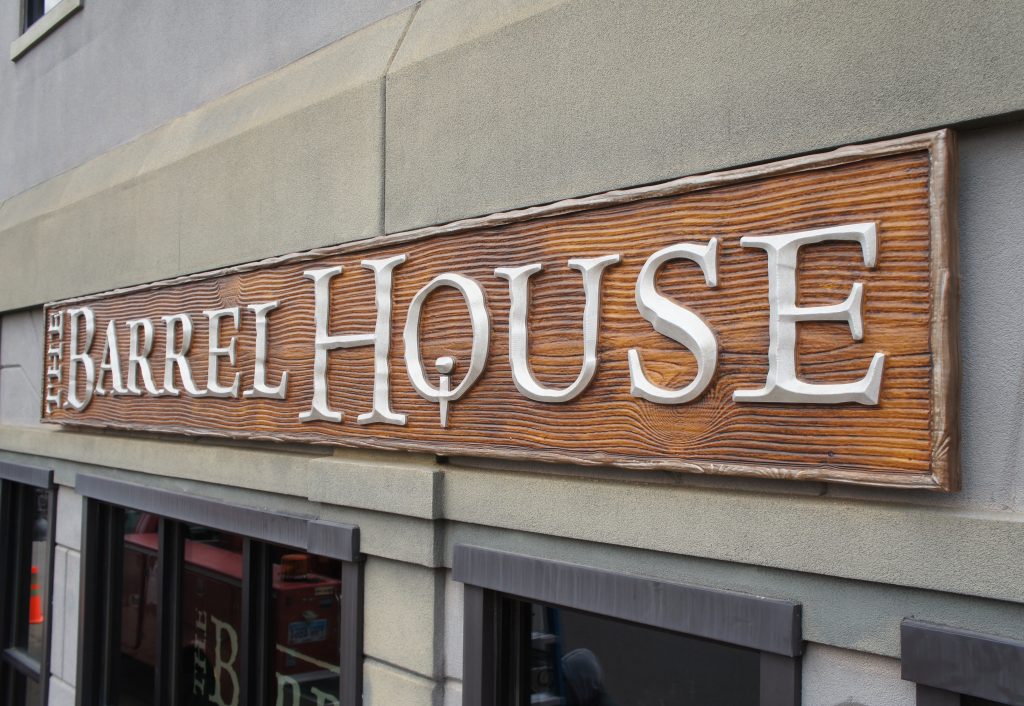There’s something nostalgic about a wood sign, so it’s not surprising that people want to have signs that appear to be made out of wood, but without the drawbacks- rotting, warping, or deteriorating. Brian Quinter of Quint Creative Signs has created so many faux wood grain textured signs from Precision Board HDU that it’s become almost second nature. They even have names for it- ‘Basic Wood Grain Texture’ and ‘Super Realistic Wood Grain’. Quint Creative has fabricated hundreds of signs that look like wood and dozens with the Super Realistic Wood Grain. We talked to Brian to get some tips and tricks for making faux wood signs from Precision Board HDU.

Brian Quinter first started making faux wood signs seven years ago that looked like sandblasted wood signs. That changed when a job came to him about four years ago for The Barrel House. They wanted something that looked like an old sign that may have been found in a barn with deep wood grain and a natural wood finish. That was when he started making the Super Realistic Wood Grain textured signs.
To achieve their super realistic wood grain Brian uses Vectric Aspire. He creates 3D components from two different bitmaps of wood grain. Brian often finds a texture first on the internet and uses it to create a 3D Component. The second he creates using Corel Draw, which he converts to a bitmap and edits in Corel Photopaint. He uses an Eye Candy plugin to make his grains look how he wants and then creates a 3D Component. Brian then bakes both textures together as one 3D component and finishes the design in Vectric Aspire. He uses a 3D Finishing toolpath with a .25 Ballnose bit.
“I usually include elements like knots and often bring the texture and faux painting onto the framing of the sign. I find having some machining lines help make it look even more like wood when we do the glazing after we paint it,” said Quinter. “I do basic textures using Aspire’s Texturing Toolpath tool, but I like to do Full 3D wood grain for the higher end signs,” he added.
Brian prefers Precision Board HDU over actual wood because he can control what he makes.
“If I’m using wood and trying to expose the natural grain, I don’t know what I’m going to get. If I hit a knot, it can mess me up.” He added, “I can deliver what I’m designing without worrying about problems during fabrication and my client gets what they have been shown in a proof.” (Ed note: the above photo is an example of a proof- the one that Brian showed to Hawk’s Nest)
Hawk’s Nest is his most recent faux wood design for a sign. They were looking for rustic, so they wanted something that looked like wood instead of going with flat plastic or aluminum. The sign was fabricated using PBLT-15 that was 1.5” thick for the background. The letters were also made out of PBLT-15 and were 1.5” thick. Nova Color paints and glazes were used for the entire project, including the metallic silver and gold.
Brian used convex letters to give the sign some highlights and shadows. If you look at the letters, the sides are painted black and the front is painted the main color for the letter.
“There’s a lot of little touches that help bring it together that may not be noticed by the normal person,” says Quinter.
Brian has some advice for those just starting out with faux wood signs.
“The hardest thing is color choice when you start painting it. Some of that is experimental to achieve the wood look.” He added, “Prime it. Give it a base coat with a mustardy color. Glaze it and then wipe it off to give it highlights. Start with lighter and work to darker colors. Textures also help when glazing and leaving some of the darker colors of paint set in the texture”
Quint Creative just recently did another faux wood project for the local park system.
“We just replaced some wood signs for Tipp City Parks that were faded and deteriorating and used Precision Board HDU made to look like wood,” Brian added.
The signs were rotting and the client wanted them updated with something sturdy and weather-resistant. The results speak for themselves!
In the end says Quinter, “going with a faux wood textured Precision Board sign will give you a classy, traditional sign that stands out and lasts forever.”
Quint Creative Signs creates one of a kind signs that help set any type of business or organization apart from others. With attention to detail and knowledge of what really works in sign design, QCS signs get noticed where ever they are installed. Give them a call at (937) 615-9332 or visit their website. You can check out a lot more photos of Brian’s faux wood work in galleries here and here.
Make sure to sign up for our monthly Blog Roundup to get more content like this sent to your inbox for reading when it’s convenient for you! Request free samples of Precision Board HDU or any of our companion products, including adhesives, primers and coatings.
SEE ALSO: